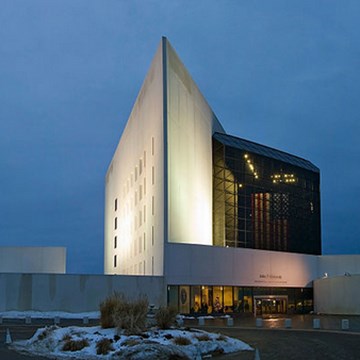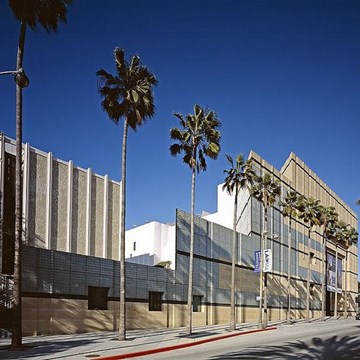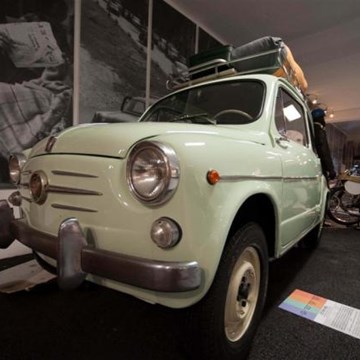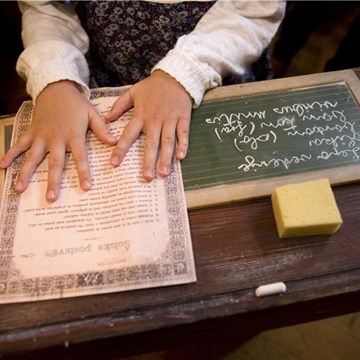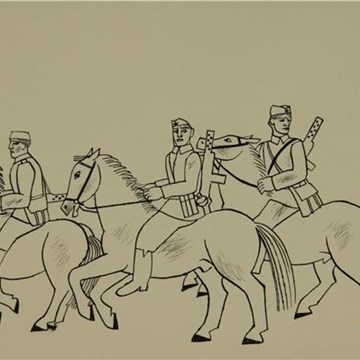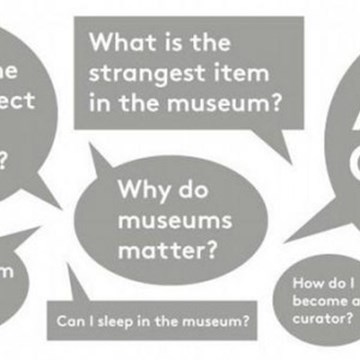- Home
- Carnegie Museum of Natural History
- ICOM International Museum Day at Carnegie Museum of Natural...
ICOM International Museum Day at Carnegie Museum of Natural History
We’re offering special programming all day on May 18th to celebrate ICOM International Museum Day at Carnegie Museum of Natural History! This day has been recognized around the world since 1977 as a way to raise awareness for the importance of museums.
Live Animal Encounter: Debuting Antonio the Anteater
Earth Theater ($2 per person) and via Livestream
May 18, 1:30 p.m.
Antonio the anteater will make his debut for ICOM International Museum Day! Join Living Collection Manager Mallory Vopal in person or online to meet Antonio. He’s a fiery, young, lesser tamandua, a species native to South America. His tongue is over 12 inches long and he has a very distinctive smell, find out why these two traits are helpful to Antonio at his public debut.
Watch the livestream on our Facebook page.
Architecture and Geology in the Grand Staircase
Grand Staircase and via Livestream
May 18, 12:30 p.m.
Listen to geologist Albert Kollar and manager of architecture Alyssum Skjeie discuss the stone architecture of our Oakland museum complex live from the Grand Staircase. Learn the stories behind the stones from architect’s imagination to the building we see today.
Watch the livestream on the Carnegie Museum of Art Facebook page.
Meet the Researchers
Carnegie Museum of Natural History
May 18, 12:15-5 p.m.
Free with admission
Nineteen of our researchers will be in the galleries to answer questions and discuss the exhibits throughout the day. Talk to them to learn the tales that don’t make it to museum placards.
12:15-12:45 P.M.
Albert Kollar, Collection Manager for Invertebrate Paleontology, in the Grand Staircase
Geologist Albert Kollar will be in the Grand Staircase to share information about his current research on the architectural stones used in our museum building. He will be traveling to Croatia, France, Italy, and Ireland to further study the origin of the beautiful stonework here in Oakland.
1:00-2:00 P.M.
Andrew McAfee, Scientific Illustrator, in Dinosaurs in Their Time
Andrew works in vertebrate paleontology to produce illustrations of dinosaurs based on the facts researchers can gather from fossils, bones, and educated guesses. He’ll be doing a live drawing demonstration and answering questions about scientific illustration.
Bonnie Isaac, Collection Manager of Botany, in Hall of Botany
Bonnie manages the museum herbarium (collection of dried plants). She’s an expert in rare plants and ecology. Ask her about Prenanthes crepidinea, a plant in the dandelion family that she proved could be removed from the Pennsylvania endangered species list.
1:00-3:00 P.M.
Catherine Giles, Curatorial Assistant of Invertebrate Zoology, in Third Floor Exhibition Foyer
Catherine completed her Masters in Sustainability at Chatham University where she researched Lepidoptera(butterfly and moth) monitoring in the southwest region of Pennsylvania. She can introduce you to the unique characteristics of invertebrates housed on the third floor.
Debra Wilson, Collection Manager of Minerals and Gems, in Wertz Gallery: Gems & Jewelry in Hillman Hall of Minerals and Gems
Debra’s love of minerals and gems began with photographing them in the 1980s and traveling with her husband Marc to learn more about them at gem and mineral shows around the country. Debra will gladly tell you all kinds of stories about the minerals and gems in Hillman Hall and Wertz Gallery.
1:30-2:30 P.M.
Bob Androw, Project Coordinator-BSF/Scientific Preparator, in Grand Staircase
Bob’s main interests lie in the taxonomy, distribution and life histories of the Cerambycidae (longhorned beetles) and Scarabaeidae (scarab beetles). In his role as coordinator of the Biodiversity Services Facility (BSF), he is responsible for processing USDA trap samples to identify invasive species, in particular bark beetles. Be sure to ask Bob about these insect threats to our environment.
1:30-3:00 P.M.
John Rawlins, Curator of Invertebrate Zoology, in Third Floor Exhibition Foyer
John has a wide variety of professional interests but primarily researches butterflies and moths. He and his staff even raise their own Lepidoptera (butterflies and moths) at the museum.
Jim Fetzner, Assistant Curator of Invertebrate Zoology, in Third Floor Exhibition Foyer
Jim’s research digs into the conservation and population genetics of freshwater crayfish. He’s recently worked with endangered and rare populations in Missouri, Mississippi, and Arkansas.
2:00-3:00 P.M.
Nicole Heller, Curator of the Anthropocene, in We Are Nature
Nicole is the world’s first Curator of the Anthropocene. Her research revolves around promoting biodiversity as we see the impacts of climate change and other ways humans have altered ecosystems. If you’re curious about climate change, chat with Nicole.
Matt Lamanna, Assistant Curator of Vertebrate Paleontology, in Dinosaurs in Their Time
Matt is our principal dinosaur researcher. He’s discovered multiple new dinosaur species on his expeditions around the world to places like Antarctica, Greenland, Egypt, and Australia. He always has fun stories to tell about his expeditions and discoveries.
John Wible, Curator of Mammals, in Hall of African Wildlife and Hall of North American Wildlife
John is particularly curious about evolutionary relationships between extinct and living mammals. Ask him how he uses skulls to learn about these relationships.
Steve Rogers, Collection Manager of Amphibians and Reptiles/Birds, in Bird Hall
In addition to his experience in collection management, Steve has 40 years of experience in taxidermy. Ask him anything you’ve ever wanted to know about scientific preparation and preservation of animals on display.
Timothy Pearce, Assistant Curator of Mollusks, outside Earth Theater
Timothy has a special affinity for snails and clams. His current research involves the distribution of land snails in the northeastern United States, especially Pennsylvania. He cares for over 1.8 million clam and snail specimens here at the museum, ask him about his favorite species.
3:00-4:00 P.M.
Amy Covell, Curatorial Assistant in Anthropology, Alcoa Foundation Hall of American Indians
Amy has worked at the museum for over ten years and is particularly skilled in working with and preserving fragile artifacts. Ask her about her favorite pieces in the Hall of American Indians.
Mason Heberling, Postdoctoral Research Associate in Botany, in We Are Nature
Mason’s research focuses on looking at invasive species traits over time based on herbarium data. Invasive species have a profound impact on the environment, ask him why.
Gretchen Anderson, Conservator, Collection Care and Conservation, in Hall of North American Wildlife Temporary Visible Conservation Lab
Since 2009, Gretchen has worked to improve the environmental conditions of the museum and to preserve the exhibits and specimens. Ask her anything you want to know about museum conservation.
3:30-4:30 P.M.
Bob Androw, Project Coordinator-BSF/Scientific Preparator, in Grand Staircase
Bob’s main interests lie in the taxonomy, distribution and life histories of the Cerambycidae (longhorned beetles) and Scarabaeidae (scarab beetles). In his role as coordinator of the Biodiversity Services Facility (BSF), he is responsible for processing USDA trap samples to identify invasive species, in particular bark beetles. Be sure to ask Bob about these insect threats to our environment.
3:00-5:00 P.M.
Robert Davidson, Collection Manager of Invertebrate Zoology, in Third Floor Exhibition Foyer
Robert’s research is currently focused on Carabidae (Coleoptera), also known as ground beetles. He’s the person to ask about the local Carabidae of Pennsylvania and West Virginia, but he’s also traveled all over the world to do fieldwork.
4:00-5:00 P.M.
Suzanne McLaren, Chair of Collections, in Hall of African Wildlife and Hall of North American Wildlife
Suzanne first began working in the Section of Mammals in 1977. Her research is focused primarily on mammals in the eastern United States, especially our own backyard of Pennsylvania and West Virginia.
Erin Peters, Assistant Curator of Science and Research, in Walton Hall of Ancient Egypt
Erin specializes in Roman Egypt and is currently part of a research project to create an architectural and archeological picture of the ancient city of Antinoupolis. She’s completed three seasons of field research in Egypt and can answer your questions about what you see on display in Egypt Hall as well as what she’s learned on her travels.
Exhibitions and events from this museum
We don't have anything to show you here.
Activities from this museum
We don't have anything to show you here.



